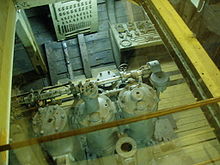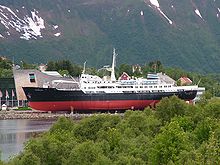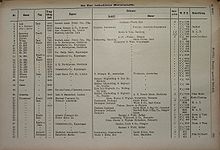Motor ship

A motor ship is a ship that is powered by an internal combustion engine - usually a diesel engine. The abbreviation MS for motor ship or MV for English motor vessel , sometimes also written M / S or M / V, is often placed in front of the ship name, but is not part of it.
commitment
Around 1980, large two-stroke engines were the most important propulsion engines for shipping ; today it's four-stroke engines . Two-stroke engines with high performance are mainly installed in large, fast container ships as single or double systems with an engine and propeller speed of 95-105 / min. The medium-speed four-stroke engines (350–450 rpm) share the rest, with very few exceptions. These four-stroke engines with an output of over 13,000 kW are installed in the Queen Elizabeth 2 , for example . Four-stroke engines are preferred for smaller ships because they are not as tall as the slow-running cross-head two- stroke engines. Two-stroke engines are mostly slow runners with 94–120 rpm. Four-stroke engines are medium-speed runners with revolutions of 350-450 / min or high-speed runners with revolutions from 2,000 to 2,300 / min. Two-stroke engines (with overall heights in some cases well over 10 meters and a total weight of up to 2,500 tons) are usually installed as individual machines; Four-stroke engines as single, double, triple, quadruple and multiple systems.

Heavy fuel oil has been used as fuel in shipping since around 1970 . It has a density of up to 0.99 g / cm³. In order to be able to pump this oil, it must be preheated to at least 60 ° C. The heavy oil is preheated to 130 to 140 ° C for injection into the engine. In inland shipping , however, only gas oil is used. Larger marine diesel engines are started with highly compressed air (10–35 bar). Heavy oil-powered large diesel engines therefore require several auxiliary units and systems such as diesel generators, oil boiler systems for generating steam to heat the heavy oil tanks, various cooling water and lubricating oil pumps, fuel feed pumps, air compressors and compressed air tanks.
To reverse (for forward or backward travel of the ship), the camshaft is shifted either pneumatically or hydraulically on the engine itself , or the engine maintains its direction of rotation and acts on a reversing gear . A third variant is the hydraulic or mechanical adjustment of the propeller blades .
Modern passenger ships today often have a diesel-electric drive : Diesel generators generate electricity and one or more electric motors drive the propeller (s).
history

development
Shortly after its invention, the diesel engine was used for boats, and soon after for inland waterways . In 1910, Roald Amundsen had the research ship Fram , built in 1892, equipped with a diesel engine for his South Pole expedition . The Danish shipping company Det Østasiatiske Kompagni (East Asiatic Company) had the first ocean-going motor ship, the cargo and passenger ship Selandia , built at the Burmeister & Wain shipyard in Copenhagen . The 4964 gross register tons measured Selandia was 117 meters long, 16 meters wide and had a draft of 9 meters. With two reversible four-stroke diesel engines from Burmeister & Wain, each with an output of 920 kW (1250 hp), the two-screw ship reached a speed of 12 knots (22.2 km / h). On her maiden voyage , she covered 22,000 nautical miles (40,000 km).
Due to the development of steam turbines in turbine ships , steam propulsion dominated seafaring until the end of the Second World War . Even in larger warships there were no diesel engines until then; the only exception to this were the three Germany-class armored ships .
From the 1950s, motor ships dominated the construction of new ships, as they were more efficient, took up less space and required less material. Turbine ships were only built until the 1970s when the performance requirements were very high. At the beginning of the 21st century, 97% of all large ships are motor ships. The largest marine diesel engines produce more than 110,000 HP (81 MW) in the version with 14 cylinders. The largest engines in the 14-cylinder version come from MAN B&W (14 K 98 MC-C) and from Wärtsilä ( 14 RT-flex 96C ).
Timetable
- 1903: Inland tanker Vandal on the Volga , owned by Maschinenfabrik Ludvig Nobel , length 70 meters, also the first diesel-electric ship in the world.
- 1903: Petit Pierre ( Canal de la Marne au Rhin , France). Two-cylinder opposed piston with 25 HP (18.4 kW). Rudolf Diesel was on board for the maiden voyage .
- 1904: Uto as the first experimental motor ship on Lake Zurich . Conversion of the Schwalbe screw steamer .
- 1904: Diesel-powered test submarine Z of the French Navy .
- 1910: The Fram of Roald Amundsen was equipped with a diesel engine as an auxiliary motor.
- 1912: Selandia , the world's first large ocean-going motor ship (Burmeister & Wain, four-stroke diesel engine with 800 kW each).
Environmental properties
Motor ships are considered an ecological means of transport; they imply some systemic disadvantages. They have a relatively high degree of efficiency and consume (in relation to the transport performance ) considerably less energy compared to land transport ( railways , trucks ) and especially compared to airplanes .
Marine diesel engines can be operated with diesel fuel , marine diesel oil , heavy oil ("HFO") or, for some time now , with liquefied natural gas .
Above all, the relatively cheap Bunker C oil (heavy oil) has a high sulfur content (according to IMO up to 4.5%); When it is burned, large quantities of sulfur oxides , soot and nitrogen oxides are produced . The mineral oil industry also uses shipping as a disposal option for fuels that contain particularly sulfur, which cannot be used on land for technological and political reasons. In the event of accidents (e.g. collisions, sinking) of motor ships, fuel can leak into the sea ( oil spill ).
Attempts are currently being made to reduce emissions with new designs ( common rail diesel and water injection into the combustion chamber). Catalytic converter technology with selective catalytic reduction (SCR), which comes from power plant construction , is already widespread . With it, the nitrogen oxide content of the exhaust gases is catalytically reduced by injecting urea solution .
Some port cities are trying to promote the spread of clean propulsion systems for motor ships through exhaust-related port fees.



